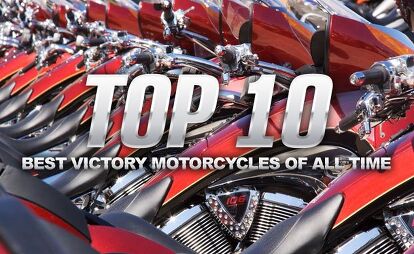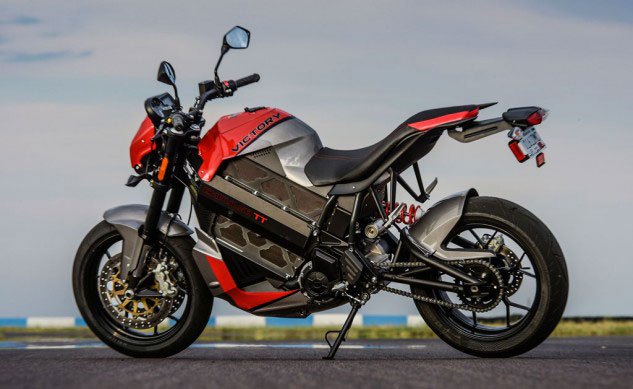Top 10 Best Victory Motorcycles Of All Time

With Victory being shuttered today, we look back at the high points of the brand
Today marked the end of an era, with Polaris announcing it was closing down its Victory Motorcycles operations after 18 years of building cruisers to compete with the might of Harley-Davidson. It would’ve been 20 years ago this June that Al Unser Jr. rode a V92C into the Mall of America’s Planet Hollywood at its debut to the world.
Polaris is Closing Victory Motorcycles
Victory says it has produced 60 models over the years, and 2012 was the year of its biggest sales volumes, somewhere between 10,000 and 15,000 units. However, the cruiser market is relentlessly competitive, and with continual developments from Harley and the reintroduction of Indian from parent company Polaris, the business case for Victory had dwindled.
“Closing down Victory was a tough decision for us,” Steve Menneto, Polaris VP of Motorcycles, told us today. “But it allows investments in Indian to grow in the area of performance. Now there’s nothing constraining Indian to go into new segments of performance and technology.”
So, as the marketplace turns a page on the Victory Motorcycles epoch, we looked back through our nearly two decades of experience with the brand to select our favorite models. As with all subjective lists, yours might look different. Let us know your favorites in the comments section below.
10. Empulse TT
What?! A Victory (well, Brammo) electric bike is on this list? Before you get up in arms about the Empulse TT being here consider this: Victory’s existence was about daring to be different in its market, and the Empulse TT took that philosophy to the next level and promised a techie new direction. With parent company Polaris’ acquisition of Brammo, the Empulse fell under the company umbrella, and with its sporting/racing heritage (the Empulse’s racing brother, the TT Zero racer, earned a podium spot at the Isle of Man TT), the Victory camp seemed a fitting destination for the Empulse TT.
Whether you like it or not, electric vehicles will have a stake in the future of mobility, and while Victory may be shutting its doors for good, Polaris reps tell us the electric side of the business will continue on – this isn’t the last you’ve seen of the Empulse and the further development of e-bikes from Polaris. That alone is significant enough to have the Empulse TT on this list. Is the world ready for an Indian with an electric motor? –Troy Siahaan
9. Gunner
With our official Victory fanboy, Evans Brasfield, out attending a top secret moto media function, we’re putting together this list without input from our cruiser regular. But in his First Ride Review of the $12,999 Gunner, Brasfield scored the bare bones bike an 88%, which is commendable considering the bike’s lack of modern electronics. But this is exactly the bike’s attraction – an analog motorcycle in a digital world. What the Gunner also had going for it is character, an attribute of most Victory models, but especially so with the Gunner.
Says Brasfield, “Victory has created a stylish and capable cruiser with tons of attitude and a fit and finish that belies its low (for big-inch cruisers) price. While you don’t get any bells and whistles, like color options or ABS, $12,999 buys a Big Twin with plenty of attitude, performance, and comfort.”–Tom Roderick
8. Cross Roads
Essentially a Cross Country sans batwing fairing and radio, the Cross Roads was a simpler yet very capable tourer for those wanting less frills. The powerful 106 V-Twin is one of our favorites, but more impressive was the overall package surrounding that engine. A well-dialed suspension, good brakes, and comfy ergos for a variety of body types were things we didn’t expect from the Cross Roads, allowing us to get out our sporty urges every now and then during our Leather Baggers Shootout of 2014, where the CR went up against the Triumph Thunderbird LT, Harley-Davidson Heritage Softail Classic, and Indian Chief Vintage. Even more surprising was the Cross Roads’ victory (pun intended) in that test, due in large part to the bike’s overall balance. Ultimately, the Cross Roads lost out in sales to its fairing-equipped Cross Country brother, eventually resulting in the axe for the Cross Roads. –Troy Siahaan
7. Vision
The old saying “ahead of its time” applies to the 2007 Victory Vision as well as to almost any motorcycle. The sheer audacity of its George Jetson styling immediately threw the staid touring bike audience for a loop, and unusual (modern) engineering touches like moving the gas tank forward and building the whole thing on an advanced aluminum frame provoked even more caution from the intended audience. Which is a shame, because this is one fine-cruising cruiser, with its smooth-running counterbalanced Twin, sweet-handling, rattle-free chassis and proverbial plush accommodations.
By 2010, Victory produced this Vision 8-Ball, slammed, blackened and precursing the current bagger explosion. But it was all for naught; Vision sales never approached lackluster, and Victory refocused its main effort into the more traditional Cross Roads and Cross Country bikes. We could be wrong, but if any Victory is collectible, it could be this one. –John Burns
6. Kingpin
The Kingpin has most of the slinky style details of the pretty Vegas – including a frenched-in LED taillight that caps off the curvaceous rear end – but adds a sportier edge with its own inverted fork and a 130/70-18 front tire as opposed to the narrow 90/90-21 on the front end of the Vegas. The ’Pin therefore was sharper handling and better balanced at all speeds than the chopper-esque Vegas, even if its bulkier fenders added a few extra pounds. When equipped with a windshield and bags, the Kingpin could be transformed into a mile-munching touring cruiser, with roomy floorboards never cramping legs. –Kevin Duke
5. Hammer
Victory introduced its first power cruiser, the Hammer and Hammer S, in 2005. The Hammers were also one of the first Victory models to jump in early on the huge rear-tire trend, wearing a 250/40-18. For the occasion, Victory invited the moto media to Austin, Texas, where we we spent a day enjoying the undulating features of Texas Hill Country and gorging ourselves on Texas bar-b-que. One of the tastiest Victory press launches we ever attended.
“The Hammer presents a mixed bag of improvements,” summarized Sean Alexander in his 2005 Victory Hammer & 8-Ball Intro report. “Its fit and finish are outstanding, and the new Freedom 100/6 powerplant should be standard on all of Victory’s motorcycles. However, this bike is really more of a styling exercise than a true rider’s motorcycle.” –Tom Roderick
4. V92C
Polaris Industries presented its motorcycle calling card in the late-90s with a prototype cruiser dubbed the V92C. Production began in late 1998 with consumer bikes coming to market as 1999 production models. Victory’s first motorcycle was a praiseworthy effort but a long way off from challenging established cruiser champion, Harley-Davidson, which is easily gleaned from our 1998 report on the V92C.
“It’s hard to not get swept up in the excitement of a new bike manufacturer on the market,” we wrote back in the day. “When the lights go down and there’s a big show on the center stage, anything looks hot and sexy. But when the balloons lose their helium and the janitor comes through with the mop, reality sets in: The Victory just doesn’t have anything to set it apart from the other cruisers on today’s market. Taking design cues from vintage cruiser bikes, cars and aviation styles is not new to this market.” –Tom Roderick
3. Octane
There was a lot of anticipation when Victory unveiled the Project 156. Built in conjunction with Roland Sands Design, the P156 was built to tackle one of America’s last great races: the Pikes Peak International Hill Climb. If that wasn’t exciting enough, the power for the racer was another hot-button topic: a prototype (at the time) V-Twin with items you don’t normally associate with Victory: liquid-cooling, huge 67mm throttle bodies, and titanium valves. There was no way this engine, or some derivative of it, wouldn’t make it into production. The question, of course, was what it would be.
The Octane (and Indian Scout, but that’s another story) was the answer. While many (including us) were disappointed that the Octane wasn’t a sporty bike but instead a power cruiser, that shouldn’t negate the fact the Octane is one hell of a power cruiser. With 1179cc, 88.6 hp, and 66.9 lb-ft of torque, the Octane will snap the rear end loose with a twist of the wrist. The engine likes to rev, and if you’re willing to oblige then there’s plenty of fun to be had. There were some hiccups like abrupt on/off throttle, but there was no question it was a definite departure for Victory. We were looking forward to seeing what was to come with this platform – or at least the engine. Oh well. Better start looking across the aisle at Indian. –Troy Siahaan
2. Vegas
While we cheered on the addition of another American motorcycle company to the scene in the Y2K era, we were skeptical of Victory achieving true sales success when its bikes looked significantly more homely than the products in Harley dealerships. That changed when the Vegas debuted in 2003, a new design from the pen of Polaris’ Michael Song featuring lovely details like the scalloped and sculpted fuel tank with a ridged spine mimicking the spine on both fenders. Now that a Vic looked as good or better than its competition, we could more easily appreciate features like Brembo brakes, an aluminum swingarm, extra power, and a superior clutch and transmission. –Kevin Duke
1. Cross Country
New for 2010, Victory’s Cross Country was built to go head-to-head with a certain other American manufacturer’s bagger – complete with frame-mounted fairing (with sound system), hard saddlebags and not a lot else save for that ubiquitous 106-cubic inch V-Twin. Well, it also had a much better chassis than its main competitor (aluminum rather than steel), complete with 4.3 inches of rear suspension travel.
Later it would evolve into the excellent CC Tour Deluxe pictured above, complete with trunk, cruise control and all the rest of it, but all the CCs were superb, bulletproof long-distance motorcycles.
The original CC was good enough to be our Cruiser of the Year in 2010. It won out over an H-D Street Glide and a Yamaha (nee “Star”) in this 2011 comparison. And EiC Duke enjoyed an epic jaunt to Sturgis on this special Cory Ness Signature Edition. –John Burns

Motorcycle.com presents an unrivaled combination of bike reviews and news written by industry experts
More by Motorcycle.com Staff


































![Top 10 Motorcycles of All Time [video]](https://cdn-fastly.motorcycle.com/media/2023/05/07/11554528/top-10-motorcycles-of-all-time-video.jpg?size=350x220)
















Comments
Join the conversation
Gave this book to her boyfriend, he was satisfied, because He is fond of motorcycles, in particular their history. I just like the logo of this brand https://motorcycle-logos.co... and the speed that creates the feeling of flying (only on a flat track!)
The Hammer presents a mixed bag of improvements,” summarized Sean Alexander in his 2005 Victory Hammer & 8-Ball Intro report